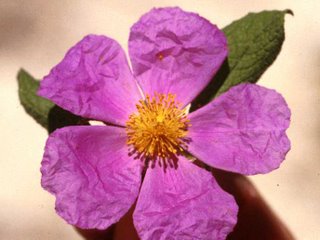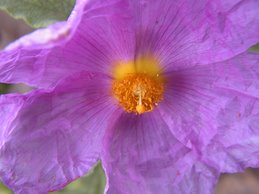



http://web.odu.edu/webroot/instr/sci/plant.nsf/pages/cistus
Why There May Be No Balm in Gilead(1)
Balm of Gilead is an image familiar to Bible students even though it is mentioned in only
two verses. The weeping prophet, as Jeremiah is known, writes in Jeremiah 8:22, "Is there
no balm in Gilead? Is there no physician there? Why then is there no healing for the wound
of my people?" What is this product of Gilead?
First, what is Gilead? According to the biblical account in the book of Joshua(2), Gilead is
apparently the region from the middle of the Arnon Gorge (Wadi Mujib) to Mount Hermon
(Jebel Al Sheik) with the Jabbok River (Zarqa River) being the middle of the territory. This
included the domain of the Ammonites and the Amorites as well as the region known as
Bashan. In division of territory to the patriarchs, Gilead was apportioned to the half tribe of
Manasseh (the other half remained west of the Jordan River), Reuben, and Gad.
Although a small area in terms of square kilometers, Gilead is diverse stretching from the
margins of the Jordan valley and the peaks along the Rift Valley to the edge of the Badia
(steppe). In ancient times parts of Gilead were covered with forests. These forests were the
Balm of Gilead http://web.odu.edu/webroot/instr/sci/plant.nsf/pages/cistus
2 of 8 29/11/2004 10:16 µµ
southernmost extension of their kind, and the southern extreme of the range of the Aleppo
pine. Today, only vestiges of these forests remain. A prime example is Dibbeen National
Park.
At Dibbeen and scattered other remnants in the area, the forest is dominated by the Aleppo
pine. This tree is familiar to anyone who has visited Jordan because it is widely planted. It
probably only formed extensive forests, however, in areas with higher rainfall. Pines are the
dominant trees but oak (ballot), pistacia (buttim), and carob (kharrob) are also present.
A feature of the natural pine forest is a distinct stratification of the vegetation. The trees are
the upper layer. Much closer to the ground is a layer of shrubs, dominated by two species of
the genus Cistus. More on these later. Closer yet to the soil are numerous non-woody plants,
many of them in the legume family.
One of the characteristics of plants found in this vegetation type is the presence of essential
oils, literally oils that have an essence. Pine would fit this category as would numerous of
the understory shrubs. Some, like the legume Ononis, have sticky hairs. Others, like various
members of the mint family, lack the sticky hairs but contain oils that are evident when the
plant is crushed.
If the forest is degraded through heavy grazing, the oaks will predominate. This sort of
forest is evident in the hills north of Ajlon as at Istayfanah. Here, you will not see a distinct
stratification although the flora is rich and diverse. In the spring, the forest contains showy
plants such as orchids and anemones which are most common at the margins where more
light is available.
For me, the most desirable time to visit Dibbeen is in the late spring in the afternoon. Shrubs
are still green, some flowers of Cistus are present. After the hot day, resin is obvious on the
plants. Pine leaves, Cistus, and various native mints combine to give a sweet fragrance. The
long rays of the sun in the late afternoon cast a special light over the forest. The clear,
brilliant rays and contrasting shadows create a primeval ambience. It is quiet except for that
special, calming sound of a light breeze through the leaves of the pine. In the distance you
can sometime hear a shepherd playing his pipe. In a personal sense, this is a balm in Gilead
for me!
Two species of Cistus are common in the pine forest, C. creticus and C. salvifolius. They are
easily distinguished by their flower color. The large pink flowers of C. creticus and the
slightly smaller but equally beautiful white flowers of C. salvifolius appear in May. On a hot
day, the fragrant resin of the plants is obvious. Upon closer examination, you can see the
numerous hairs that cover the leaves and young stems of both species. The resin will stick to
your hands if you collect leaves.
Cistus' resin is fragrant, as noted, and has been used for millennia to produce an incense.
Even today, the resin is collected in parts of Greece. It can be harvested in a variety of ways.
One ancient method is to comb the hair of goats who graze in plant communities where
Cistus is abundant. Another is by dragging a rake with long, leather tines across the shrubs
at the hottest time of day and then removing the resin when it is dry(3). To my knowledge, it
does not have any widespread use among modern Arabs.
Balm of Gilead http://web.odu.edu/webroot/instr/sci/plant.nsf/pages/cistus
3 of 8 29/11/2004 10:16 µµ
I have not found any local familiarity with the plants. When some Bedouin near Anjara were
asked the value of the plant, they simply replied that it was good forage for sheep and goats
indicating why the shrub is absent in heavily grazed areas.
The resin is also used for medicine, as a balm that can reduce inflammation of the skin.
Recent research on the biochemistry of the plant has shown the efficacy of compounds in
the plant for dermatological disorders(4).
Other resins extracted from plants in this type of Mediterranean community include mastic.
This is derived from the sap of at least two species of the genus Pistacia. The highest
quality comes from P. lentiscus on the Greek island of Chios. Such trees may have occurred
in Gilead in ancient times. However, there is no documentation for this. Another candidate
is the resin of the Aleppo pine which has been used as a pitch and gum. Use of the resin for
balm is unknown.
Back to Gilead. Is it possible these species of Cistus were widespread and more common
throughout Gilead and used as a medicine? Could this be the balm of Gilead? Again, the
weeping prophet in Jeremiah 46: 11: "Go up to Gilead and get balm, O virgin daughter of
Egypt. But you multiply remedies in vain; there is no healing for you." This implies that
Gilead was a special source of the medicine. If so, why was Gilead chosen as a site for
harvesting the balm rather than similar areas west of the Jordan? We simply don't know. Nor
should we neglect the possibility that the prophet Jeremiah was speaking in a metaphorically
way.
What is certain is that the beautiful Cistus shrubs, perhaps the most likely candidate for the
balm of Gilead, are much less frequent now then in previous years. This is due to the
widespread destruction of the forest type that harbors them. To ensure that future
generations of Jordanians can appreciate these attractive members of the indigenous flora,
they need to be protected. This can only be done by preserving the forest in which they
grow. Otherwise, there will be no balm in Gilead.
ENDNOTES
1. Adapted in part from Musselman, L. J. 2000. Jordan in Bloom.
2. Joshua 12:2.
3. Baumann, H. 1996. The Greek Plant World in Myth, Art and Literature. Translated by W. T. and E.
R. Stearn. Portland: Timber Press.
4. Baumann, H. 1996. The Greek Plant World in Myth, Art and Literature. Translated by W.
T. and E. R. Stearn. Portland: Timber Press. Danne, A., F. Peterett and A. Nahrstedt. 1993.
Proanthocyanidins from Cistus incanus. Phytochemistry 34(4): 1129-1133.
Rock rose
In my last lecture, I spoke at length about rockrose, or Balm of Gilead. Because it may be
Balm of Gilead http://web.odu.edu/webroot/instr/sci/plant.nsf/pages/cistus
4 of 8 29/11/2004 10:16 µµ
confused with some of the other plants used for balm, especially myrrh, I want to refer to it
again and draw upon some recent research.
Two species of Cistus are common in Syria, C. creticus and C. salvifolius. They are easily
distinguished by their flower color. The large pink flowers of C. creticus and the slightly
smaller but equally beautiful white flowers of C. salvifolius appear in May. On a hot day,
the fragrant resin of the plants is obvious. Upon closer examination, you can see the
numerous hairs that cover the leaves and young stems of both species. The resin will stick to
your hands if you collect leaves.
Cistus' resin is fragrant, as noted, and has been used for millennia to produce an incense.
Even today, the resin is collected in parts of Greece. It can be harvested in a variety of ways.
One ancient method is to comb the hair of goats who graze in plant communities where
Cistus is abundant. Another is by dragging a rake with long, leather tines across the shrubs
at the hottest time of day and then removing the resin when it is dry(1). To my knowledge, it
does not have any widespread use among modern Arabs.
The resin is also used for medicine, as a balm that can reduce inflammation of the skin.
Recent research on the biochemistry of the plant has shown the efficacy of compounds in
the plant for dermatological disorders(2). Recent research in Turkey shows that, of the seven
plants used as folk remedies for ulcers, the one with the greatest efficacy was C.
salvifolius(3).
Endnotes
1. Baumann, H. 1996. The Greek Plant World in Myth, Art and Literature. Translated by W.
T. and E. R. Stearn. Portland: Timber Press.
2. Danne, A., F. Peterett and A. Nahrstedt. 1993. Proanthocyanidins from Cistus incanus.
Phytochemistry 34(4): 1129-1133.
3. Yesilada E., I. Gurbuz, and H. Shibatajavascript: do_literal('AU=(Gurbuz I)');. 1999.
Screening of Turkish anti-ulcerogenic folk remedies for anti-Helicobacter pylori activity.
Journal of Ethnopharmacology 66(3):289-93. (The other plants were Spartium junceum,
cones of Cedrus libani, herbs and flowers of Centaurea solstitialis ssp. solstitialis, fruits of
Momordica charantia, herbaceous parts of Sambucus ebulus, and flowering herbs of
Hypericum perforatum.)
Balm of Gilead http://web.odu.edu/webroot/instr/sci/plant.nsf/pages/cistus
5 of 8 29/11/2004 10:16 µµ
Balm of Gilead http://web.odu.edu/webroot/instr/sci/plant.nsf/pages/cistus
6 of 8 29/11/2004 10:16 µµ
Balm of Gilead http://web.odu.edu/webroot/instr/sci/plant.nsf/pages/cistus
7 of 8 29/11/2004 10:16 µµ
Balm of Gilead http://web.odu.edu/webroot/instr/sci/plant.nsf/pages/cistus
8 of 8 29/11/2004 10:16 µµ



1 comment:
viagra buy viagra for sale without a prescription womens viagra viva viagra song viagra rx viagra mexico viagra prescription uk buying viagra in uk viagra england viagra online uk which is better cialis or viagra viagra free sites computer find viagra attorneys viagra manufacturer
Post a Comment